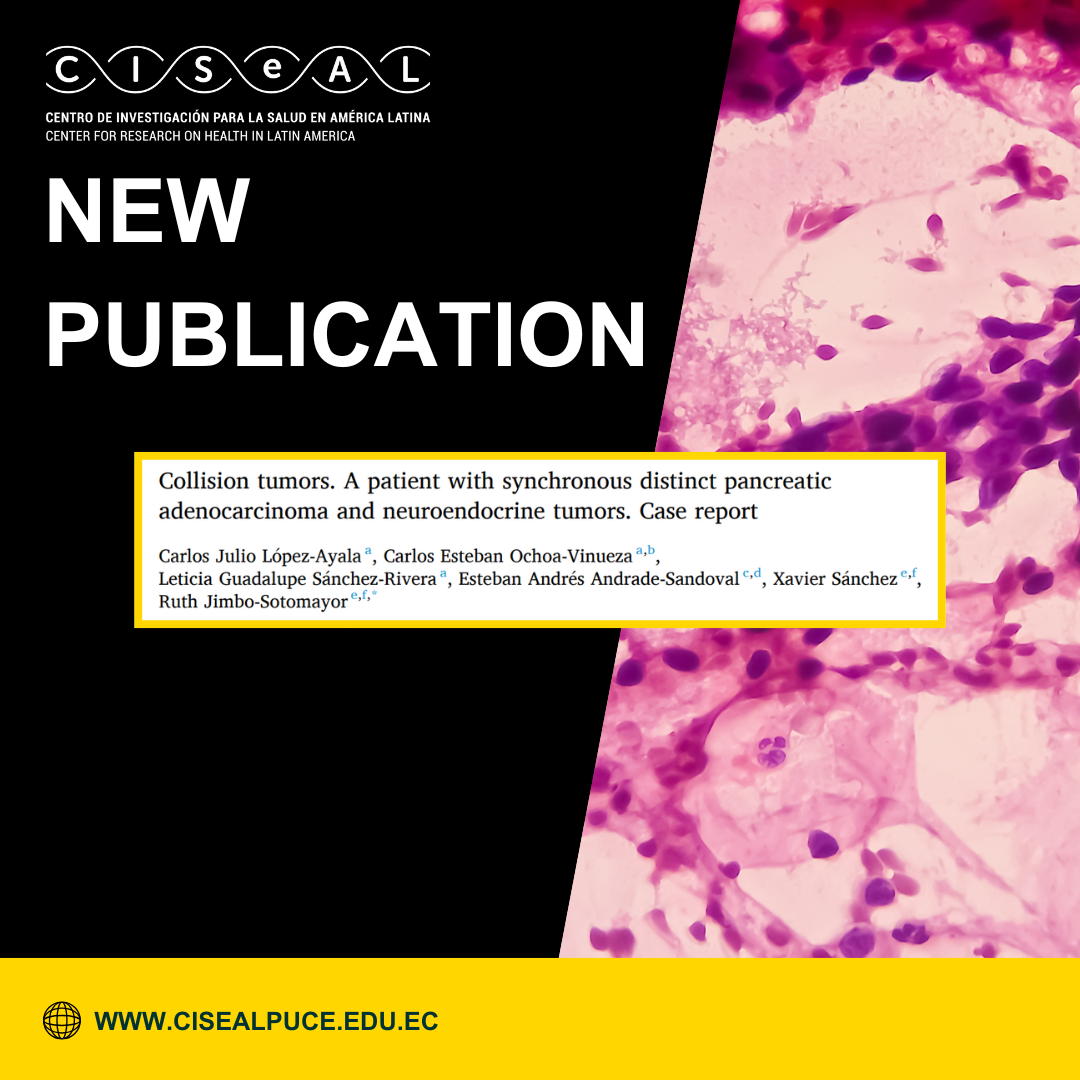 Pancreatic adenocarcinoma represents a growing problem in Western countries due to its increasing incidence, difficult early diagnosis related to nonspecific symptoms, and intrinsic aggressiveness that translates into low overall survival (≈12% at 5 years), whereas neuroendocrine tumors (NETs) generally show a better prognosis and, in the pancreas, account for only ~2% of pancreatic neoplasms; the synchronous coexistence of both within the spectrum of multiple primary tumors (5–10% in the population) is exceptional. In this context, and with the participation of CISeAL principal investigators Dr. Ruth Jimbo-Sotomayor and Dr. Xavier Sanchez, we document the case of a 52-year-old man with type 2 diabetes who presented with three weeks of abdominal pain, weight loss, and anorexia without jaundice; laboratory studies showed mild hyperbilirubinemia, elevated transaminases, and a cholestatic pattern, and MRCP plus angiotomography revealed dilation of the bile duct and duct of Wirsung along with an 18 mm lesion in the pancreatic head without vascular invasion, clinically staged as IA. After ERCP biliary stent placement and preoperative evaluation, a robot-assisted cephalic duodenopancreatectomy (Whipple procedure) was performed, allowing precise dissection and lymphadenectomy; the postoperative course was uneventful. Histopathology identified a moderately differentiated adenocarcinoma with perineural and lymphovascular invasion, three negative nodes, and pathologic stage IB (pT2 pN0 pMX), as well as a separate incidental finding: a well-differentiated neuroendocrine tumor confined to the pancreatic head (pT1 pN0 pMX) with a low proliferative index, constituting a synchronous collision-type (biphasic) tumor and not a mixed neuroendocrine–nonendocrine neoplasm (MiNEN), in which both components should be admixed and each represent >30% of the mass. The patient received six cycles of FOLFOXIRI chemotherapy over eight months and then concurrent chemoradiotherapy with capecitabine (total dose 50.4 Gy at 13 months) and continues to do well, with no evidence of tumor activity on quarterly follow-up.
Pancreatic adenocarcinoma represents a growing problem in Western countries due to its increasing incidence, difficult early diagnosis related to nonspecific symptoms, and intrinsic aggressiveness that translates into low overall survival (≈12% at 5 years), whereas neuroendocrine tumors (NETs) generally show a better prognosis and, in the pancreas, account for only ~2% of pancreatic neoplasms; the synchronous coexistence of both within the spectrum of multiple primary tumors (5–10% in the population) is exceptional. In this context, and with the participation of CISeAL principal investigators Dr. Ruth Jimbo-Sotomayor and Dr. Xavier Sanchez, we document the case of a 52-year-old man with type 2 diabetes who presented with three weeks of abdominal pain, weight loss, and anorexia without jaundice; laboratory studies showed mild hyperbilirubinemia, elevated transaminases, and a cholestatic pattern, and MRCP plus angiotomography revealed dilation of the bile duct and duct of Wirsung along with an 18 mm lesion in the pancreatic head without vascular invasion, clinically staged as IA. After ERCP biliary stent placement and preoperative evaluation, a robot-assisted cephalic duodenopancreatectomy (Whipple procedure) was performed, allowing precise dissection and lymphadenectomy; the postoperative course was uneventful. Histopathology identified a moderately differentiated adenocarcinoma with perineural and lymphovascular invasion, three negative nodes, and pathologic stage IB (pT2 pN0 pMX), as well as a separate incidental finding: a well-differentiated neuroendocrine tumor confined to the pancreatic head (pT1 pN0 pMX) with a low proliferative index, constituting a synchronous collision-type (biphasic) tumor and not a mixed neuroendocrine–nonendocrine neoplasm (MiNEN), in which both components should be admixed and each represent >30% of the mass. The patient received six cycles of FOLFOXIRI chemotherapy over eight months and then concurrent chemoradiotherapy with capecitabine (total dose 50.4 Gy at 13 months) and continues to do well, with no evidence of tumor activity on quarterly follow-up.
This case supports etiologic hypotheses that include genetic predisposition, shared environmental factors, and a possible histogenetic relationship between exocrine and endocrine lineages arising from multipotent precursor cells or from chronic inflammatory processes driving neuroendocrine differentiation; it also underscores that when two pancreatic tumors are detected, the symptomatic lesion (here, the adenocarcinoma) usually dictates prognosis, yet the therapeutic plan should integrate both components, and the presence of a low-grade NET should not discourage aggressive surgical strategies for ductal carcinoma. Given that reports of adenocarcinoma/NET collision tumors are scarce—particularly in Latin America—disseminating regional experiences such as this one is key to improving clinical suspicion, refining imaging–pathology correlation, standardizing multidisciplinary decision-making, and advancing understanding of the natural history and treatment response of true synchronous epithelial/neuroendocrine tumors of the pancreas.
Do you want to know more details?
We invite you to read the full article at the following link:



